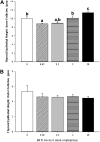Effects of chronic exposure to an environmentally relevant mixture of brominated flame retardants on the reproductive and thyroid system in adult male rats
- PMID: 22387749
- PMCID: PMC3355309
- DOI: 10.1093/toxsci/kfs098
Effects of chronic exposure to an environmentally relevant mixture of brominated flame retardants on the reproductive and thyroid system in adult male rats
Abstract
Brominated flame retardants (BFRs) are incorporated into a wide variety of consumer products, are readily released into home and work environments, and are present in house dust. Studies using animal models have revealed that exposure to polybrominated diphenyl ethers (PBDEs) may impair adult male reproductive function and thyroid hormone physiology. Such studies have generally characterized the outcome of acute or chronic exposure to a single BFR technical mixture or congener but not the impact of environmentally relevant BFR mixtures. We tested whether exposure to the BFRs found in house dust would have an adverse impact on the adult male rat reproductive system and thyroid function. Adult male Sprague Dawley rats were exposed to a complex BFR mixture composed of three commercial brominated diphenyl ethers (52.1% DE-71, 0.4% DE-79, and 44.2% decaBDE-209) and hexabromocyclododecane (3.3%), formulated to mimic the relative congener levels in house dust. BFRs were delivered in the diet at target doses of 0, 0.02, 0.2, 2, or 20 mg/kg/day for 70 days. Compared with controls, males exposed to the highest dose of BFRs displayed a significant increase in the weights of the kidneys and liver, which was accompanied by induction of CYP1A and CYP2B P450 hepatic drug-metabolizing enzymes. BFR exposure did not affect reproductive organ weights, serum testosterone levels, testicular function, or sperm DNA integrity. The highest dose caused thyroid toxicity as indicated by decreased serum thyroxine (T4) and hypertrophy of the thyroid gland epithelium. At lower doses, the thickness of the thyroid gland epithelium was reduced, but no changes in hormone levels (T4 and thyroid-stimulating hormone) were observed. Thus, exposure to BFRs affected liver and thyroid physiology but not male reproductive parameters.
Figures







Similar articles
-
Gestational and Early Postnatal Exposure to an Environmentally Relevant Mixture of Brominated Flame Retardants: General Toxicity and Skeletal Variations.Birth Defects Res B Dev Reprod Toxicol. 2016 Jun;107(3):157-68. doi: 10.1002/bdrb.21180. Epub 2016 Jun 10. Birth Defects Res B Dev Reprod Toxicol. 2016. PMID: 27286044
-
Exposure to an environmentally relevant mixture of brominated flame retardants affects fetal development in Sprague-Dawley rats.Toxicology. 2014 Jun 5;320:56-66. doi: 10.1016/j.tox.2014.03.005. Epub 2014 Mar 23. Toxicology. 2014. PMID: 24670387
-
Gestational and Lactational Exposure to an Environmentally-Relevant Mixture of Brominated Flame Retardants: Effects on Neurodevelopment and Metabolism.Birth Defects Res. 2017 Apr 17;109(7):497-512. doi: 10.1002/bdr2.1021. Epub 2017 Mar 24. Birth Defects Res. 2017. PMID: 28398660 Free PMC article.
-
Toxic effects of brominated flame retardants in man and in wildlife.Environ Int. 2003 Sep;29(6):841-53. doi: 10.1016/S0160-4120(03)00107-7. Environ Int. 2003. PMID: 12850100 Review.
-
Environmental release and behavior of brominated flame retardants.Environ Int. 2003 Sep;29(6):665-82. doi: 10.1016/s0160-4120(03)00123-5. Environ Int. 2003. PMID: 12850086 Review.
Cited by
-
2,4,6-Tribromophenol Interferes with the Thyroid Hormone System by Regulating Thyroid Hormones and the Responsible Genes in Mice.Int J Environ Res Public Health. 2016 Jul 12;13(7):697. doi: 10.3390/ijerph13070697. Int J Environ Res Public Health. 2016. PMID: 27420076 Free PMC article.
-
Toxic Effects and Mechanisms of Polybrominated Diphenyl Ethers.Int J Mol Sci. 2023 Aug 30;24(17):13487. doi: 10.3390/ijms241713487. Int J Mol Sci. 2023. PMID: 37686292 Free PMC article. Review.
-
Long-term exposure to decabrominated diphenyl ether impairs CD8 T-cell function in adult mice.Cell Mol Immunol. 2014 Jul;11(4):367-76. doi: 10.1038/cmi.2014.16. Epub 2014 Apr 7. Cell Mol Immunol. 2014. PMID: 24705197 Free PMC article.
-
The association between brominated flame retardants and serum testosterone levels in American adult men: NHANES 2013-2016.Front Public Health. 2025 Jul 17;13:1589047. doi: 10.3389/fpubh.2025.1589047. eCollection 2025. Front Public Health. 2025. PMID: 40746672 Free PMC article.
-
In Utero and Lactational Exposure to Flame Retardants Disrupts Rat Ovarian Follicular Development and Advances Puberty.Toxicol Sci. 2020 Jun 1;175(2):197-209. doi: 10.1093/toxsci/kfaa044. Toxicol Sci. 2020. PMID: 32207525 Free PMC article.
References
-
- Akutsu K, Takatori S, Nozawa S, Yoshiike M, Nakazawa H, Hayakawa K, Makino T, Iwamoto T. Polybrominated diphenyl ethers in human serum and sperm quality. Bull. Environ. Contam. Toxicol. 2008;80:345–350. - PubMed
-
- Alaee M, Arias P, Sjodin A, Bergman A. An overview of commercially used brominated flame retardants, their applications, their use patterns in different countries/regions and possible modes of release. Environ. Int. 2003;29:683–689. - PubMed
-
- Allen JG, McClean MD, Stapleton HM, Webster TF. Critical factors in assessing exposure to PBDEs via house dust. Environ. Int. 2008;34:1085–1091. - PubMed
-
- Barter RA, Klaassen CD. Reduction of thyroid hormone levels and alteration of thyroid function by four representative UDP-glucuronosyltransferase inducers in rats. Toxicol. Appl. Pharmacol. 1994;128:9–17. - PubMed

